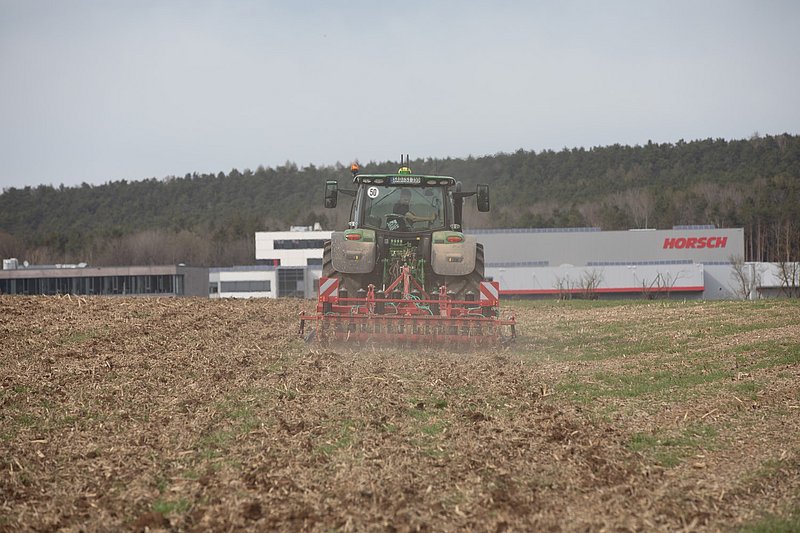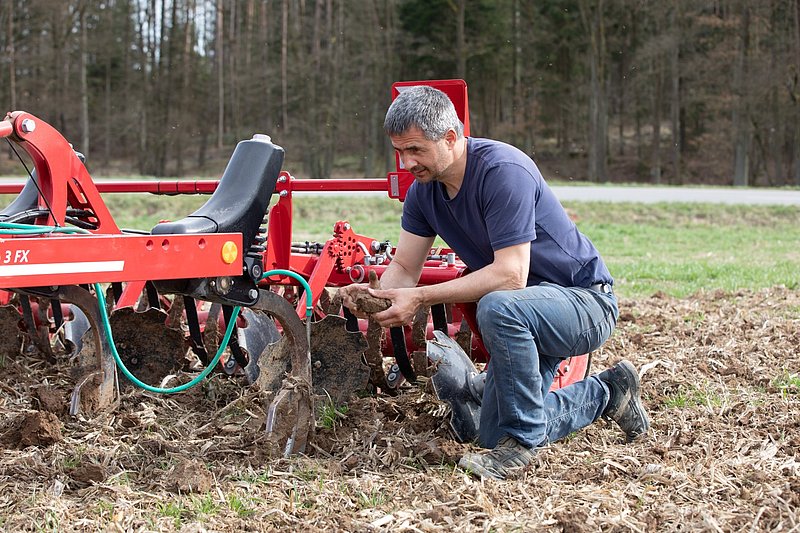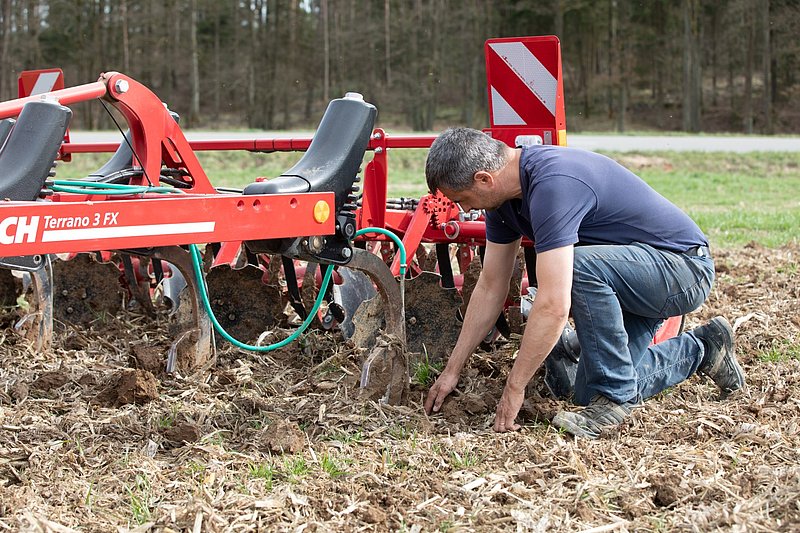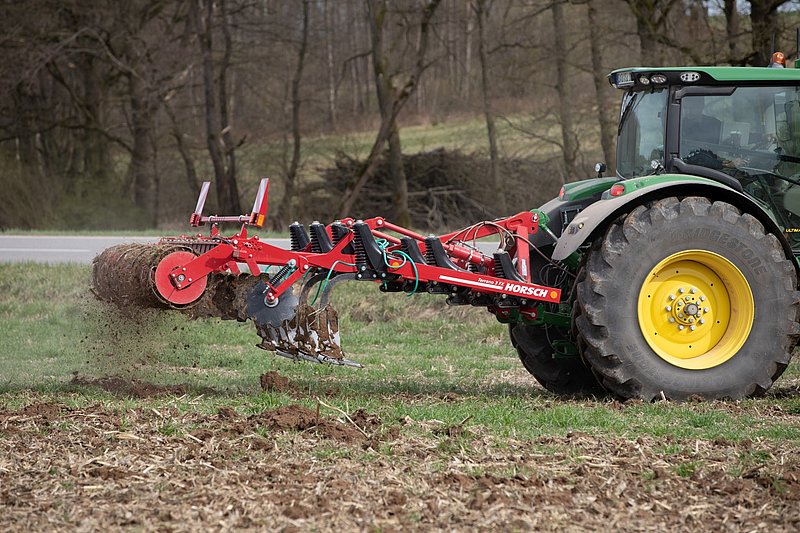New ways in farming
Marco Horsch cultivates the fields of the family farm at Sitzenhof. To optimise the cultivation of his fields even further, he intensely deals with the conditions of the soil, tests new things and experiments to gather his own experiences. In issue 20/2020 we already described his alternative methods. Now read about his current experiences.

terraHORSCH: Which methods did you test this year and how did they work?
Marco Horsch: In spring, I wanted to carry out my first tea measure, but I gave up as I noticed that it did not work with my kind of sprayer. A compost tea should not be spread with a track pressure of more than 3 bar. This would work with my boom but in front of the boom there was a pressure of more than 15 bar. So I have to adapt the technology before I continue. Otherwise, it does not make sense because the microorganism probably are already dead before they hit the soil and the plant. In the past years, I loosened my soil more deeply than before without mixing. I used my Terrano with less tines, but it was equipped with ULD coulters. I partly injected plant ferments and I also worked with sauerkraut juice. I have not yet achieved my final aim, but I can already see some first positive results.
terraHORSCH: Which changes do you notice?
Marco Horsch: During a regenerative farming seminar we carried out a spade test. And it showed that the soil was perfectly crumbly in the spots where I injected the sauerkraut juice. Around these spots the soil was considerably harder. In theory, we assume that a good plant ferment is better than sauerkraut juice as it provides a larger variety of microorganism. You can buy compost teas and plant ferments, but they are really expensive, especially if you want to use them on large fields. This is why I tried to produce the ferment myself. Unfortunately, it did not work. Instead of a pleasant, earthy smell, it smelt ripe. I have not yet found out why. There probably was something in it that was not meant to be. I then bought ferment. The difference was obvious: even after a long period of rest it smelt pleasant.
Moreover, this year, I tried to use a bacteria mixture. It was meant to generate up to 60 kg nitrogen in the wheat or cereal population. I used the mixture as I was told. But now I see that the wheat is starving. This means: The 60 kg nitrogen did not reach its destination. So I fertilised a second time with AHL.

terraHORSCH: What kind of bacteria mixture is it? How did you apply it?
Marco Horsch: I wanted bacteria that generate nitrogen from the air and from the soil – exposed nitrogen collectors – and make it available to the plants. In spring, I mixed it into the liquid manure and applied both together. The mixture is to be applied into the soil and this is how it works best. It even rained after the application. Everything was in due proportion. But I cannot see any result. With maize I injected it into the soil underground – now I am waiting if I will see the difference.
I then experimented with bacteria that are sprayed on the leaf and that are to create nitrogen on the leaf. But this did not show any effect. To prevent my barley from starvation, I had to fertilise again with AHL. There are lots where I treated one half with one kind of bacteria and the other half with the second version – this was as different as day and night. I learnt: It is not that easy. I may have made mistakes with regard to the application, or the climate may have played a role. Bacteria needs certain temperatures, certain humidity conditions and some need ultraviolet light. In retrospect, spring was rather suboptimal for my purpose. Now the climate conditions are better. It is warmer, wetter and there is more sunshine, i.e. the plants now can produce energy by means of photosynthesis. I am convinced that it will have a positive effect on the plant growth, the nutrient supply etc. if you encourage the biology in the soil. But it is difficult to find the right way.
terraHORSCH: What about catch crops?
Marco Horsch: I will continue to pursue the topic of catch crops, even if this year I suffered some severe setbacks. For example, I had a hibernating catch crop with little plant mass in spring. I let the larger catch crop mixture grow and wanted to cultivate the population two weeks before sowing maize. However, it was not that simple as the grass had generated a lot of root mass. This is good for the structure of the soil, but it makes it even more difficult to cultivate the population. First, I tried the compact disc harrow – it did not work at all. The rotary cultivator performed a little bit better. I finally had to wait for almost two weeks, make another pass with the compact disc harrow and the rotary cultivator to get the soil ready for sowing. For neighbouring farms, too, it was difficult to prepare the soil because it was very wet below but dry and cloddy on the surface. Some of my fields are rather stony and this made it even more difficult.
Next year I will probably grow a catch crop that freezes off and only grow hibernating catch crops on a small scale just to give it another try. For so far, I still do not have the appropriate technology. With the rotary cultivator it simply does not work. It remains to be seen how the hibernating catch crop affects the biology of the soil. I should perhaps have pursued my two-fold strategy more intensely to see a difference.
I want to continue but I have to act more specifically and first of all gather more experiences before I put it into practice on a larger scale. I probably will try to establish a catch crop even earlier after the cereals and before the spring crops to allow for a longer period of growth.

terraHORSCH: 2021 you applied an underseed in maize. How did you establish it and what was your objective?
Marco Horsch: I also applied it with the liquid manure tank. However, its emergence was not regular. There were quite a lot of plants in some spots and no plants at all in others. If we sow catch crops with our liquid manure co-operative, we suck in the seed continuously during the filling process. The slurry tanker of the contractor was not equipped with such a device, and I fed the seed via the dome. I believe that this is why it settled on top and was not distributed evenly.
The population partly was very good but non-existent in some spots. My idea would be to improve the soil structure in a targeted way and to establish a hardy catch crop. I hardly see a positive effect in the grain maize population as there is all the straw that blocks growth. We mulched the straw but this in turn blocked the grass, too. Perhaps I should have applied the seed with a machine instead of the liquid manure technology. I will perhaps try this again on 2 to 3 ha.
terraHORSCH: What are your plans with regard to rotation?
Marco Horsch: In general, my objective is to have a varied rotation – cereals, maize, soya, cereals, rape every five years. For it is important to include a certain share of spring crops and not too many cereals, especially because of the whole weed problems and illnesses etc. I think that with the varied rotation everything is a little bit easier with regard to weeds. Previously I had to fight quite a lot of grass, but this is no longer necessary, and the field doesn’t look worse.
terraHORSCH: What about soya?
Marco Horsch: I hope everything is well as I cultivated quite a lot of soya. Sowing did not work out as I imagined but if the result is approximately like last year I am satisfied. Last year, I harvested approx. 4 t of soya. There definitely is potential for soya in the rotation. And currently it is subsidised via the varied rotation with extensive legumes. Once this subsidy is cancelled, I do not know if I will continue to cultivate it. I have grown soya many times with a rather mediocre success. Last year, I had a rather large share of soya and a good yield with a positive result. The years before I simply grew soya as a test and the yields were disappointing with 2.5 to 3.0 tonnes.

terraHORSCH: Are you planning to test leaf fertilisers etc. in soya?
Marco Horsch: Not yet. Last year I only sprayed herbicides and nothing else – no fungicides or insecticides. I will perhaps test some micronutrients.
terraHORSCH: How many per cent of your fields did you examine intensely?
Marco Horsch: I examined the exchange capacity of all fields – as a mixed analysis for all my field types. And if I regard all the nutrients, I am not completely off the mark. I can still improve something but nothing essential. For my large field, I sold CO2 certificates for the first time respectively I entered a partnership. I’ll wait and see what will come of it. I will only get the result in four to five years as the process takes a little bit longer.
terraHORSCH: What is your summary?
Marco Horsch: My summary is that in the future I will not hurl myself this quickly into such a topic and I will rely more on my own gut feeling next year. So I did not achieve any big successes but I gathered a lot of experiences. Sometimes learning hurts!